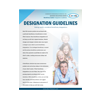BENEFICIARY DESIGNATION
Most people have a good idea of who they intend to name as beneficiaries, but often, beneficiary designations do not keep up with their intentions. Marital changes and changes to family status may require a change to your client’s current beneficiary designations. If no contingent beneficiary is named and the primary beneficiary predeceases your client, then payments would likely be made to the client’s estate, creating unnecessary delays and expenses.
A beneficiary omission may cause unnecessary probate costs and serious delays in the distribution of your client’s assets. If their beneficiary designations are out-of-date, they may not be passing property according to their current intentions. With a beneficiary review, you can help them identify potential problems and suggest ways to solve them. Following are some pieces to help you with that review.
Resources
BENEFICIARY DESIGNATION GUIDELINES
The naming of a beneficiary is one of the most important decisions faced by owners of life insurance policies. Beneficiary designations should be considered carefully and reviewed regularly. We have developed these guidelines to help you save time and avoid delays. The examples below are suggestions only; each carrier will have their own particular guidelines.
Please note that carriers have begun asking more detailed information about beneficiaries, such as addresses and social security numbers, in an attempt to better identify and track beneficiaries. We understand that some clients may object to such inquiry, but when a beneficiary is unaware of a policy and the carrier is unable to track down the persons or entities, claims can be difficult or impossible to pay. Recent litigation brought against some life insurance carriers has made such fact-finding a necessity, and carriers now ask for more information to be in a better position to find beneficiary(ies) of a known deceased insured.
BENEFICIARY DESIGNATION CHECKLIST
The below questions are designed to help the financial advisor identify some of the frequently encountered areas where beneficiary designations can create problems.
This checklist of questions and supporting discussion points can be used when establishing beneficiary designations in the original application as well as when reviewing an existing policy designation.
-
- Has the beneficiary designation been reviewed recently?
- Is the reason for having the life insurance the same as when the policy was purchased?
- Has the number of desired beneficiaries remained the same? (Ex: Number of children increased since purchasing the policy.)
- Is the marital status the same as when the policy was purchased?
- Are the beneficiaries\’ abilities to manage their financial affairs the same as when the policy was purchased?
- Has the passage of time or shifting of circumstance caused the beneficiary designation to become outdated?




